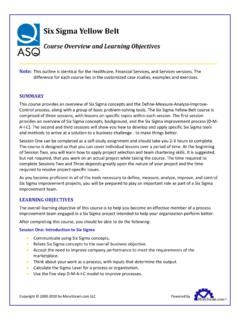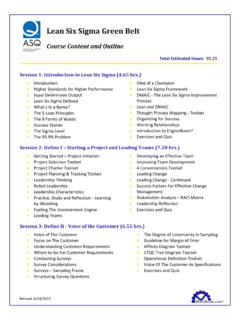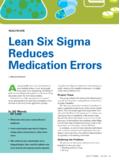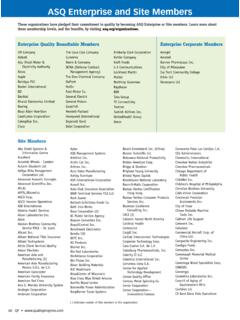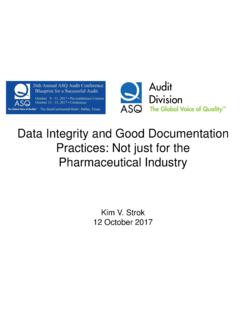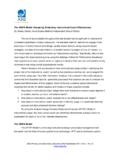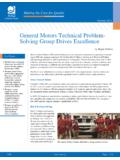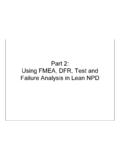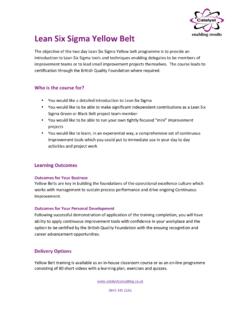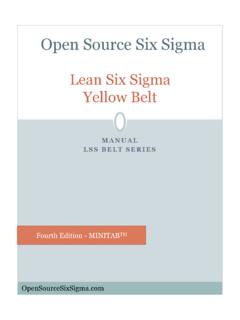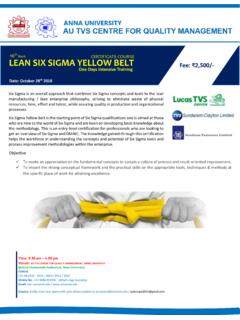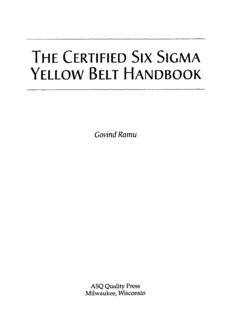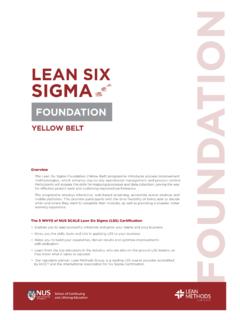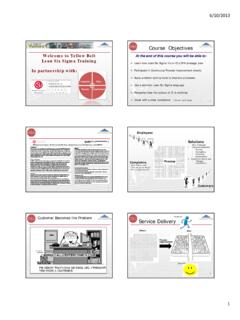Transcription of Certified Six Sigma Yellow Belt - ASQ
1 Certified Six Sigma Yellow BeltQuality excellence to enhance your career and boost your organization s bottom Global Voice of QualityTM2 Certified Six Sigma Yellow BeltCertification from ASQ is considered a mark of quality excellence in many industries. It helps you advance your career, and boosts your organization s bottom line through your mastery of quality skills. Becoming a Certified Six Sigma Yellow belt confirms your commitment to quality and the positive impact it will have on your organization. 3 Certified Six Sigma Yellow BeltExaminationEach certification candidate is required to pass a written examination that consists of multiple-choice questions that measure the comprehension of the Body of Knowledge.
2 The Certified Six Sigma Yellow belt examination is a one-part, 75-question, two-hour exam and is offered in and/or ExperienceYou must have one year s work experience. There is no educational waiver for this certification. The Six Sigma Yellow belt Certification will be aimed at those new to the world of Six Sigma who have a small role, interest, or need to develop foundational knowledge. Yellow Belts can be entry-level employees who seek to improve their world or executive champions who require an overview of Six Sigma and DMAIC. This certification will adopt the approach of advancing the concept and potential of using Six Sigma tools and methodologies within an Six Sigma Yellow belt InformationFor comprehensive exam information on Six Sigma Yellow belt certification, visit Six Sigma Yellow BeltI Six Sigma Fundamentals (21 Questions)A.
3 Six Sigma Foundations and Principles Describe the purpose of Six Sigma (reducing variation), its methodology (DMAIC), and its evolution from quality. Describe the value of Six Sigma to the organization as a whole. (Understand)B. Lean Foundations and Principles Describe the purpose of lean (waste elimination) and its methodologies (just-in-time, poka-yoke, kanban, value stream mapping). Describe the value of lean to the organization as a whole. (Understand)C. Six Sigma Roles and Responsibilities Define and describe the roles and responsibilities of Six Sigma team members ( , individual team members, Yellow belt , Green belt , Black belt , Master Black belt , process owner, champion, sponsor).
4 (Understand) D. Team Basics 1. Types of teams Identify the various types of teams that operate within an organization ( , continuous improvement, self-managed and cross-functional) and their value. (Understand) 2. Stages of development Describe the various stages of team evolution: forming, storming, norming, performing, and adjourning. (Understand) 3. Decision-making tools Define brainstorming, multivoting, and nominal group technique (NGT), and describe how these tools are used by teams. (Understand) 4. Communication methods Explain how teams use agendas, meeting minutes, and project status reports, and how they support project success.
5 (Understand)The topics in this Body of Knowledge include additional detail in the form of subtext explanations and the cognitive level at which test questions will be written. This information will provide guidance for the candidate preparing to take the exam. The subtext is not intended to limit the subject matter or be all-inclusive of what might be covered in an exam. It is meant to clarify the type of content to be included in the exam. The descriptor in parentheses at the end of each entry refers to the maximum cognitive level at which the topic will be tested.
6 A complete description of cognitive levels is provided at the end of this document. Certified Six Sigma Yellow belt (CSSYB) Body of Knowledge5 Certified Six Sigma Yellow BeltE. Quality Tools and Six Sigma Metrics 1. Quality tools Select and use these tools throughout the DMAIC process: Pareto charts, cause and effect diagrams, flowcharts, run charts, check sheets, scatter diagrams, and histograms. (Apply) 2. Six Sigma metrics Select and use these metrics throughout the DMAIC process: defects per unit (DPU), defects per million opportunities (DPMO), rolled throughput yield (RTY), cycle time, and cost of poor quality (COPQ).
7 (Apply) II Define Phase (12 Questions)A. Project Identification 1. Voice of the customer Define the voice of the customer and describe how customer needs are translated into quantifiable, critical-to-quality (CTQ) characteristics. (Understand) 2. Project selection Describe how projects are identified and selected as suitable for a Six Sigma project using the DMAIC methodology. (Understand) 3. Stakeholder analysis Identify end users, subject matter experts, process owners and other people or factors that will be affected by a project, and describe how each of them can influence the project.
8 (Understand) 4. Process inputs and outputs Use SIPOC (suppliers, inputs, process, outputs, customers) to identify and define important elements of a process. (Apply)B. Project Management (PM) Basics 1. Project charter Describe the purpose of a charter and its components: problem statement, project scope, baseline data, and project goal. (Understand) 2. Communication plan Explain the purpose and benefits of a communication plan and how it can impact the success of the project. (Understand) 3. Project planning Define work breakdown structure (WBS) and Gantt charts and describe how they are used to plan and monitor projects.
9 (Understand) 4. Project management tools Select and use various PM tools: activity network diagrams, affinity diagrams, matrix charts, relations charts, and tree diagrams. (Understand) 5. Phase reviews Explain how tollgate or phase reviews are used throughout the DMAIC life cycle. (Understand)III Measure Phase (15 Questions)A. Basic Statistics Define, calculate, and interpret measures of central tendency (mean, median, mode) and measures of dispersion (standard deviation, range, variance). (Apply)B. Data Collection 1. Data collection plans Describe the critical elements of a data collection plan, including an operational definition, data sources, the method to be used for gathering data, and how frequently it will be gathered.
10 Describe why data collection plans are important. (Understand) 2. Qualitative and quantitative data Define and distinguish between these types of data. (Understand) 3. Data collection techniques Use various data collection techniques, including surveys, interviews, check sheets, and checklists to gather data that contributes to the process being improved. (Apply)C. Measurement System Analysis (MSA) 1. MSA terms Define precision, accuracy, bias, linearity, and stability, and describe how these terms are applied in the measurement phase.
